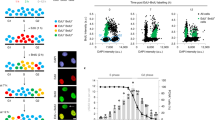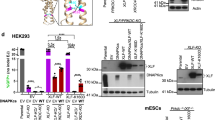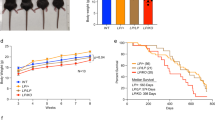Abstract
In order to analyse the relationships between regulation of apoptosis and homologous recombination (HR), we overexpressed proapoptotic Bax or only-BH3 Bid proteins or antiapoptotic Bcl-2 or Bcl-XL, in hamster CHO cells or in SV40-transformed human fibroblasts. We measured HR induced by γ-rays, UVC or a specific double-strand cleavage targeted in the recombination substrate by the meganuclease I-SceI. We show here that the induction of both recombinant cells and recombinant colonies was impaired when expressing Bcl-2 family members, in hamster as well as in human cells. Moreover, the pro- as well as antiapoptotic Bcl-2 family members inhibited HR, independently of degradation of the RAD51 recombination protein and of their impact on apoptosis. These data reveal a mechanism of HR downregulation by potentially proapoptotic proteins, distinct from and parallel to degradation of recombination proteins, a situation that should also optimize the efficiency of programmed cell death.
This is a preview of subscription content, access via your institution
Access options
Subscribe to this journal
Receive 50 print issues and online access
$259.00 per year
only $5.18 per issue
Buy this article
- Purchase on Springer Link
- Instant access to full article PDF
Prices may be subject to local taxes which are calculated during checkout








Similar content being viewed by others
References
Ausubel F, Brent R, Kingston R, Moore D, Seidman J, Smith J et al. (1999). Current Protocols in Molecular Biology. John Wiley & Sons, Inc.: Boston.
Butow RA, Avadhani NG . (2004). Mol Cell 14: 1–15.
Cherbonnel-Lasserre C, Gauny S, Kronenberg A . (1996). Oncogene 13: 1489–1497.
Cho S, O’Connor SL, McDonnell TJ . (2002). Exp Cell Res 278: 158–165.
Delsite RL, Rasmussen LJ, Rasmussen AK, Kalen A, Goswami PC, Singh KK . (2003). Mutagenesis 18: 497–503.
Flygare J, Armstrong RC, Wennborg A, Orsan S, Hellgren D . (1998). FEBS Lett 427: 247–251.
Friedberg EC, Walker GC, Siede W . (1995). DNA Repair. ASM Press: Washington, DC.
Goping IS, Gross A, Lavoie JN, Nguyen M, Jemmerson R, Roth K et al. (1998). J Cell Biol 143: 207–215.
Han Z, Malik N, Carter T, Reeves WH, Wyche JH, Hendrickson EA . (1996). J Biol Chem 271: 25035–25040.
Heimlich G, McKinnon AD, Bernardo K, Brdiczka D, Reed JC, Kain R et al. (2004). Biochem J 378: 247–255.
Huang DC, O'Reilly LA, Strasser A, Cory S . (1997). EMBO J 16: 4628–4638.
Huang Y, Nakada S, Ishiko T, Utsugisawa T, Datta R, Kharbanda S et al. (1999). Mol Cell Biol 19: 2986–2997.
Kamer I, Sarig R, Zaltsman Y, Niv H, Oberkovitz G, Regev L et al. (2005). Cell 122: 593–603.
Kaufmann T, Schlipf S, Sanz J, Neubert K, Stein R, Borner C . (2003). J Cell Biol 160: 53–64.
Kitao H, Yuan ZM . (2002). J Biol Chem 277: 48944–48948.
Krajewski S, Tanaka S, Takayama S, Schibler MJ, Fenton W, Reed JC . (1993). Cancer Res 53: 4701–4714.
Kuo ML, Shiah SG, Wang CJ, Chuang SE . (1999). Mol Pharmacol 55: 894–901.
Lambert S, Lopez BS . (2000). EMBO J 19: 3090–3099.
Lambert S, Lopez BS . (2002). Oncogene 21: 4065–4069.
Lazebnik YA, Kaufmann SH, Desnoyers S, Poirier GG, Earnshaw WC . (1994). Nature 371: 346–347.
Liang F, Han M, Romanienko PJ, Jasin M . (1998). Proc Natl Acad Sci USA 95: 5172–5177.
Liu Y, Naumovski L, Hanawalt P . (1997). Cancer Res 57: 1650–1653.
MacLachlan TK, Dash BC, Dicker DT, El-Deiry WS . (2000). J Biol Chem 275: 31869–31875.
Meyn MS . (1993). Science 260: 1327–1330.
Moynahan ME, Chiu JW, Koller BH, Jasin M . (1999). Mol Cell 4: 511–518.
Pierce AJ, Johnson RD, Thompson LH, Jasin M . (1999). Genes Dev 13: 2633–2638.
Priault M, Cartron PF, Camougrand N, Antonsson B, Vallette FM, Manon S . (2003). Cell Death Differ 10: 1068–1077.
Radman M . (1975). Basic Life Sci 5A: 355–367.
Saintigny Y, Dumay A, Lambert S, Lopez BS . (2001). EMBO J 20: 2596–2607.
Saintigny Y, Makienko K, Swanson C, Emond MJ, Monnat Jr RJ . (2002). Mol Cell Biol 22: 6971–6978.
Saintigny Y, Rouillard D, Chaput B, Soussi T, Lopez BS . (1999). Oncogene 18: 3553–3563.
Sambrook J, Fritsch EF, Maniatis T . (1989). Molecular Cloning. 2nd edn. Cold Spring Harbor Laboratory Press: Cold Spring Harbor.
Slupianek A, Schmutte C, Tombline G, Nieborowska-Skorska M, Hoser G, Nowicki MO et al. (2001). Mol Cell 8: 795–806.
Smith GC, d’Adda di Fagagna F, Lakin ND, Jackson SP . (1999). Mol Cell Biol 19: 6076–6084.
Song Q, Lees-Miller SP, Kumar S, Zhang Z, Chan DW, Smith GC et al. (1996). EMBO J 15: 3238–3246.
Suzuki M, Youle RJ, Tjandra N . (2000). Cell 103: 645–654.
Tremblais K, Oliver L, Juin P, Le Cabellec TM, Meflah K, Vallette FM . (1999). Biochem Biophys Res Commun 260: 582–591.
Wiese C, Pierce AJ, Gauny SS, Jasin M, Kronenberg A . (2002). Cancer Res 62: 1279–1283.
Wolter KG, Hsu YT, Smith CL, Nechushtan A, Xi XG, Youle RJ . (1997). J Cell Biol 139: 1281–1292.
Yin XM, Oltvai ZN, Korsmeyer SJ . (1994). Nature 369: 321–323.
Youn CK, Cho HJ, Kim SH, Kim HB, Kim MH, Chang IY et al. (2005). Nat Cell Biol 7: 137–147.
Yuan SS, Chang HL, Lee EY . (2003). Mutat Res 525: 85–92.
Yuan ZM, Huang Y, Ishiko T, Nakada S, Utsugisawa T, Kharbanda S et al. (1998). J Biol Chem 273: 3799–3802.
Zha J, Weiler S, Oh KJ, Wei MC, Korsmeyer SJ . (2000). Science 290: 1761–1765.
Zinkel SS, Hurov KE, Ong C, Abtahi FM, Gross A, Korsmeyer SJ . (2005). Cell 122: 579–591.
Acknowledgements
We thank Drs J Adams and S Cory for providing us the Y28ABcl-2 expression vector, Dr SJ Korsmeyer for the G145ABcl-2 mutant expression, Dr S Desagher for the Bid expression vector, Dr E May for the Bax expression vector, Dr M Jasin for the DRA10 cell line and the pDR-GFP plasmid, Dr R Monat for GM639 cell line and Dr D Marsh for critical reading of the manuscript. AD was supported by a fellowship from INSTN/EDF and then by Ministère de l’Education Nationale; CL is supported by a fellowship from INSTN. This work was supported by La Ligue Nationale contre le Cancer ‘Equipe labéllisée, La Ligue 2005’.
Author information
Authors and Affiliations
Corresponding author
Rights and permissions
About this article
Cite this article
Dumay, A., Laulier, C., Bertrand, P. et al. Bax and Bid, two proapoptotic Bcl-2 family members, inhibit homologous recombination, independently of apoptosis regulation. Oncogene 25, 3196–3205 (2006). https://doi.org/10.1038/sj.onc.1209344
Received:
Revised:
Accepted:
Published:
Issue Date:
DOI: https://doi.org/10.1038/sj.onc.1209344
Keywords
This article is cited by
-
Combined inhibition of BADSer99 phosphorylation and PARP ablates models of recurrent ovarian carcinoma
Communications Medicine (2022)
-
Senataxin resolves RNA:DNA hybrids forming at DNA double-strand breaks to prevent translocations
Nature Communications (2018)
-
CtIP fusion to Cas9 enhances transgene integration by homology-dependent repair
Nature Communications (2018)
-
Deregulated BCL-2 family proteins impact on repair of DNA double-strand breaks and are targets to overcome radioresistance in lung cancer
Journal of Cancer Research and Clinical Oncology (2017)
-
ATM-dependent expression of IEX-1 controls nuclear accumulation of Mcl-1 and the DNA damage response
Cell Death & Differentiation (2010)



